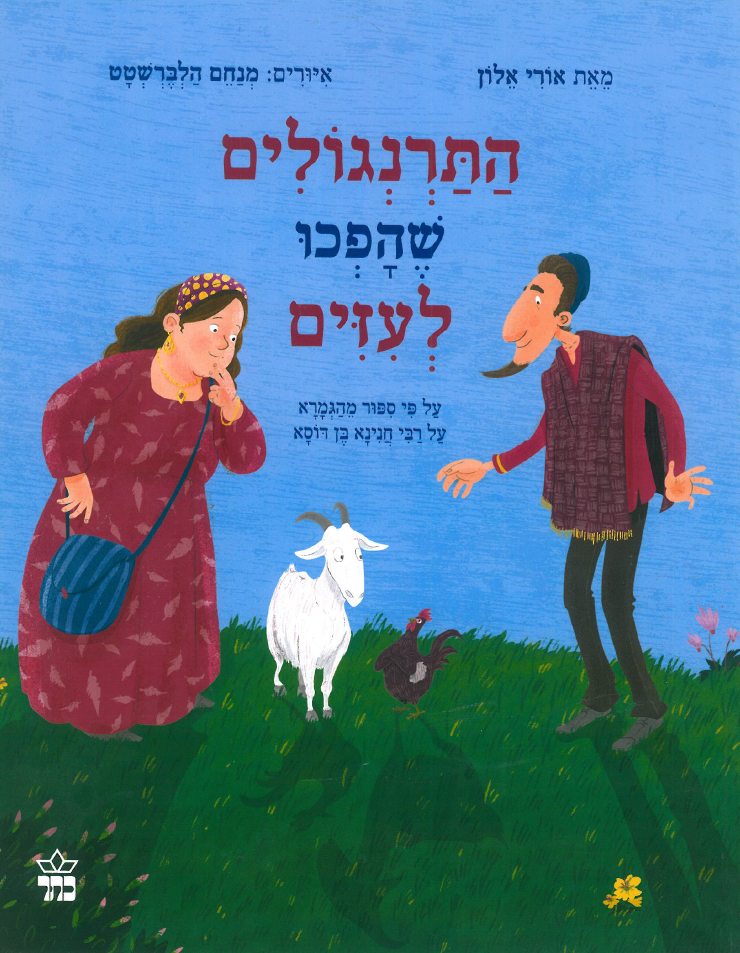התרנגולים שהפכו לעיזים
מאת: אורי אלון| איור: מנחם הלברשטט
תרגום לרוסית של ההצעות לפעילות בחיק המשפחה
Как куры стали козами
Автор: УриАлон
Иллюстрации: МенахемГальберштат
Дорогие родители!
Любой из нас, кто терял что-либо дорогое сердцу, наверняка помнит, неприятное чувство утраты. Человек, вернувший потерю, никогда не забудет, какую радость он доставил своим поступком. Мы предлагаем вашему вниманию шутливую версию древней притчи из Гемары о праведнике, звали которого раби Ханина бен-Доса. Притча повествует о потере, которая не ждет своего хозяина, а растет, множится и требует от нашедшего приложения многих усилий.
Ашаватаведа – заповедь Торы об обязанности возвращениянайденного
«Вы не находили мои ключи?»
«Я нашла мяч!»
«Нет! Это я из дома принес!»
С самого раннего возрастамы прививаем малышампринцип бережного отношения к чужим вещам. Вместе с тем, важно помнить, что вернуть найденное не так-то просто. Не всегда легко найти хозяина найденной вещи, порой бывает нелегко отказаться от находки. Именно поэтому Тора учит нас важности возврата находки законному хозяину: «И так же поступи со всякой потерей брата твоего, что будет потеряно им, а ты найдешь; не можешь ты устраниться» (Второзаконие 22, 3).
Читаем и играем дома
- Рассмотрите вместе с детьми красочные иллюстрации МенахемаГальберштата. Попросите малышей пересказать сюжет книги своими словами. Нам неизвестно, как выглядел раби Ханина бен-Доса, но мы вполне можем представить себе быт того времени и галилейскую природу. Попытайтесь найти на рисунках признакитого времени и места.
- Иллюстратор МенахемГальберштат позволил себе добавить забавные детали, отсутствующие в сюжете. Найдите страницу, на которой изображены куры во дворе. Что они делают? Рассмешило ли вас это изображение?
- Раби Ханина перечисляет отличительные признаки петуха и курицы: петух черный с белым пятном, курица белая с золотым пятнышком. Поиграйте с детьми: загадываем предмет, находящийся в комнате, и описываем его приметы; задача – правильно отгадать загаданное. У вас получилось?
- Теряли ли вы или дети любимые вещи? Удавалось ли их найти? Попытайтесь вместе вспомнить, какие чувства вы испытывали, узнав о пропаже. Если удалось вернуть пропажу, что вы чувствовали?
- Подумайте вместе о том, как уменьшить риск потери дорогих нам вещей. Выслушайте предложения детей, поделитесь с ними своими соображениями. Можно рассказать детям о том, куда приносят найденные вещи – в полицию, бюро находок и т.д.
- Поиграйте в игру «Найди петуха»: кладем ладонь на лист бумаги, оттопырив большой палец, обрисовываем руку. Большой палец – это голова, четыре пальца – крылья. Дорисовываем лапы, гребешок с клювом и вырезаем фигурку. Один из участников игры прячет бумажного петуха, остальные должны его найти. Спрятавший направляет их словами «горячо» и «холодно».
Раби Ханина бен-Доса
Один из составителей Мишны. Жил в Галилее около двух тысяч лет назад. Раби Ханина был удивительным человеком, о его скромности и других уникальных качествах характера слагались легенды. Раби Ханина бен-Доса с семьей жил в нищете, но никогда не брал чужого и всегда возвращал найденное. Писатель УриАлон адаптировал текст притчи о праведнике и пропавших курах из Вавилонского Талмуда (трактат Таанит, стр. 25, 1):
«Случилось, что некий человек был в его доме мимоходом и оставил там своих кур. Нашла их жена раби Ханины бен-Досы, сказал тот ей: «Не ешь яиц от них». Яиц и кур развелось много, не стало от этого житья, и продал он их, а на вырученные деньги купил коз. Как-то раз проходил там тот человек, у которого потерялись куры, и сказал он своему спутнику: «Здесь я оставил своих кур». Услышал раби Ханина бен-Доса, сказал ему: «Ты знаешь их приметы?» Сказал тот: «Да». Назвал ему приметы и получил этих коз» (Перевод на русский язык: Издание Штейнзальца, Иерусалим-Москва, 5758-1998).





